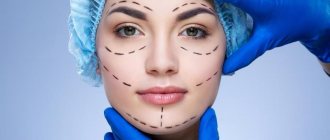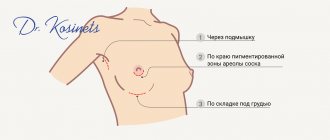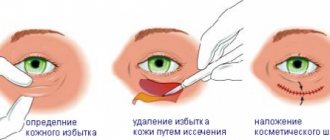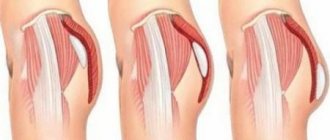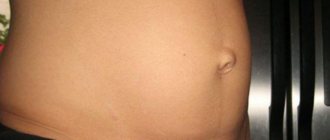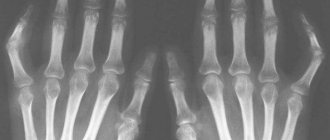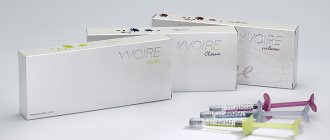Recently, many young people have been interested in the question of whether it is possible to sew up an earlobe. Such popularity of corrective surgery arose due to the recent fashion for wearing tunnels, which unaesthetically stretches the soft tissues of the hearing organ.
Plastic surgery of the earlobes may be required not only after thoughtlessly and imprudently following subcultural fashion trends. In what other cases do people need plastic surgery? How is the earlobe shape corrected?
In what cases may surgery be required?
The range of indications for ear surgery is quite wide; most often the operation is performed for cosmetic purposes to correct the irregular shape of the area of the hearing organ:
- The earlobe may stretch from wearing the so-called. “tunnels”, after removal of which an unaesthetic and even frightening hole remains.
- Soft fabrics can stretch and sag after wearing heavy jewelry for a long time.
- The earlobe can mechanically tear or even break due to earrings: such damage often occurs during changing clothes, when jewelry gets caught on clothing.
- Like any other soft tissue, the earlobe can stretch with age, sag and take on an unsightly elongated shape.
- Sometimes surgery is required for those who want to correct the inherent unaesthetic shape of the ears, including the lobes.
- The services of plastic surgeons are also often sought to remove scars from punctures, incisions and burns.
Caring for sewn earlobes
FAQ
It hurts?
It only hurts to do the anesthesia, but it only takes 5-10 seconds. After the entire procedure, you will not feel anything. If after the procedure you do not touch the lobes with your hands, then the fresh wound will hardly hurt. You should not touch it either because this can cause an infection - this will increase the healing time.
How long does it take to heal?
Primary healing lasts 2-3 weeks, then 4-8 months are spent on resorption and lightening of the scar.
Will it be possible to pierce my ears or make tunnels again later?
You can pierce again after 4-6 months, tunnels can be pulled after 6-12 months.
Will sewn-up ears look the same as they originally looked?
It’s not a fact that the master will try to make the anatomical shape of the lobes, but if the ears and/or tunnels in them were initially of different sizes, asymmetrical lobes may result. Which, however, is not critical, since for many people one ear grows 1-2 centimeters higher than the other, but no one notices this until the master says so.
What to do?
Day 0-9:
A fresh seam should be washed 2-3 times a day. You can clean it of dried blood, dead cells, other secretions and foreign dirt using peroxide, without soaking the seams themselves (this is important! otherwise the blood will come out again). To do this, just moisten a gauze or cotton swab with peroxide and apply it to the wound, remove the remaining crusts with a cotton swab. This can be done once or maximum twice.
The rest of the time, apply a cotton or gauze swab with an antiseptic for a minute or two, morning and evening. And cover it with a bandage so that dust and dirt from the street do not get into the wound.
Day 10-30:
After the stitches are removed, it will take a couple of days for the last scabs to disappear. Then you can start smearing your ears with ointments to regenerate the skin and get rid of scars. For complete care, an antiseptic (preferably Miramistin) and a patch are enough.
Day 31-90:
You should take care of sewn-up ears - do not pierce them, do not pull them, do not fiddle with them. The scars will gradually fade to a color slightly lighter than the skin.
Day 91 onwards:
Now everything is fine and you can go to us for an examination if you want to make a new piercing in the place of the old seam. As for the reconstructed tunnels, in order to proceed further, it is recommended to wait six months from the moment of the operation.
What not to do?
1. Do not use alcohol or other aggressive substances. Ointments are not needed for the first 10 days. Peroxide may only be needed to clean the area around the wound from blood.
2. Avoid visiting the bathhouse, swimming pool, sauna and solarium for 2-3 weeks.
3. Do not allow cosmetics and perfumes to come into contact with the seam.
4. Eliminate (or at least minimize) drinking alcohol, coffee, smoking and taking aspirin. All this dilates the blood vessels and increases bleeding, thereby increasing the healing period.
5. Remember that it is not miracle cures that heal a wound, but your body. Therefore, it is advisable to take doubly good care of hygiene and maintain immunity at a decent level (take a complex of vitamins and minerals, get plenty of sleep, drink a lot of clean water and exercise).
Tips and tricks
1. For healing, we advise you to start drinking tablets or tea based on mountain Arnica a week before the procedure, and take a triple dose an hour before the procedure.
2. Arnica reduces bleeding, other herbs in the drug increase the rate of tissue regeneration, normalize blood pressure and provide other beneficial effects.
3. If the bleeding does not stop for more than a day and the homeopathic remedy does not help, you need to make an appointment with your doctor.
4. Think carefully about whether you really need to sew up the tunnels.
5. You can wash your hair after 24 hours, preferably after a day and a half. Wash your hair in advance before the procedure, but keep in mind that immediately after stitching it may be slightly stained with blood, so do not plan important events the next day.
6. Change your bed linen more often, pull your hair away from your ears into a ponytail and pin it with bobby pins: a lot of dirt gets from the hair onto the wound.
7. To make the scars less noticeable, you can smear them with Mebegsha gel two to three days after removing the stitches according to the instructions for the drug.
Be healthy and beautiful with St.Scalpelburg!
Cartilage Piercing Care
Contraindications
The patient's desire alone is not enough to perform the operation. Plastic surgery may be contraindicated for the following diseases and conditions:
- A temporary contraindication for earlobe plastic surgery is infectious diseases; the operation can be performed only after the patient has fully recovered;
- due to blood clotting disorders, problems with blood pressure and pathologies of the cardiovascular system, patients are usually denied otoplasty;
- a clear contraindication for suturing the earlobe is diabetes mellitus due to the risk of postoperative complications;
- the operation will be postponed if the patient’s chronic diseases are in the acute phase;
- setting the date for surgery in women always correlates with their cycle; Since during menstruation the risk of bleeding on the surgical site increases, uroplasty is performed on other days.
Earlobe correction (plastic, enlargement): types, preparation, how it’s done, recovery
Earlobe plastic surgery is a popular procedure in the field of plastic surgery and cosmetology.
The manipulation is carried out not only for the purpose of correcting various congenital or acquired defects, but also for aesthetic reasons.
To eliminate deficiencies and improve appearance, experts offer both surgical and non-surgical techniques that do not pose any danger.
What defects can be corrected?
Earlobe correction is prescribed not only for women, but also for men. In addition, this method has no age restrictions and, for certain indications, is performed on children aged 5-7 years.
Most often, patients seek help from specialists due to the small size of the lobe as a result of a decrease in fat reserves, sagging skin or loss of elasticity.
In addition, the procedure is prescribed if there are other significant problems, such as:
- enlargement of the hole when wearing heavy jewelry;
- large holes in the ears that form after the installation of tunnels;
- sagging of the lobes, which often occurs due to age-related changes or careless stretching;
- the appearance of the first signs of aging ;
- small size ;
- gap.
Also, such manipulation is often performed when tumors are detected in the ears.
Before deciding to undergo surgery to eliminate defects and enlarge the earlobe, you must first consult with a specialist.
How to do it
The earlobe correction procedure does not require special preparatory measures. The patient must first visit a specialist who will perform a visual examination, assess the condition of the skin in the area of correction, determine the exact problem and scope of work, and also study the client’s medical history.
If the need arises, a diagnostic examination is prescribed, which is important to identify possible contraindications. The study includes:
- general blood ;
- clotting test ;
- urine test ;
- test for the detection of AIDS , hepatitis, syphilis and other sexually transmitted infections.
If no restrictions are identified, the doctor sets a date and time for the proposed manipulation.
It is also worth noting that two weeks before the intervention it is necessary to stop taking all medications that thin the blood.
Earlobe plastic surgery is performed in two ways. The choice of method for carrying out the procedure, as well as the type of anesthesia, will depend on the amount of work and tasks that need to be solved. In most cases, a local anesthetic is used. For more serious surgery, general anesthesia may be administered.
Surgical method
If the reason for the plastic surgery was a rupture of the lobe, the surgeon creates a new incision along its marginal zone. After this, the edges are sewn together using a cosmetic suture. As a rule, it is removed after a certain period.
the complexity of such an operation lies in the fact that there is increased blood circulation in this area, which requires increased attention from the specialist to the coagulation of blood vessels. This surgical intervention takes no more than 30 minutes.
If the lobe is stretched as a result of wearing tunnels or heavy jewelry, the correction procedure will be longer and more difficult to perform. Its main task is to form a new lobe, while first removing excess tissue. At the final stage, a suture is also placed on the wound surface, which is subsequently removed after 4-5 days.
If there is a tendency to form keloid scars, the cause of the problem may be ear piercing.
Over time, the keloid begins to grow, causing the lobe to completely close.
To correct such a defect, a specialist excises scar tissue and starts the process of regeneration of healthy tissue structures. After such an intervention, no traces remain of the scars.
Fillers
If the procedure for enlarging the earlobe is carried out at the request of the patient for the purpose of aesthetic correction or rejuvenation, then it is recommended to use non-surgical methods that involve the introduction of fillers.
It is worth noting right away that this tactic gives only a temporary effect, which lasts no more than one year, then the procedure must be repeated.
Most often, fillers are used that contain hyaluronic acid, which allows you to create additional volume.
During the work, injections of the drug are injected under the skin. This manipulation does not require anesthesia and is easily tolerated by patients. It takes about a week to see changes.
Clips
To enlarge a small lobe, you can use special clips. However, to achieve the desired result, they will need to be worn regularly for several months.
It is also important that only high-quality hypoallergenic plastic is used for the manufacture of such devices. Soft pads must be inserted. You can wear them for no more than one hour at a time, then take a break. This measure is necessary to prevent disruption of blood flow.
Recovery period
The time required for healing will depend on the severity of the problem and the amount of work performed. During this period, you need to adhere to certain recommendations of a specialist. If surgical intervention was performed, then you should not pierce your ears or wear earrings for 2-3 months. This can cause infection and keloid formation.
The correction area must be treated daily with antiseptic solutions. The dressing, if present, is also changed every day.
In addition, smoking and drinking alcoholic beverages are prohibited for one month.
The procedure for earlobe enlargement is becoming increasingly popular. It is easily tolerated by patients and is almost never accompanied by complications. Despite the high effectiveness of such manipulation and its safety, you should consult a specialist before performing it.
Source: https://plasticology.ru/otoplastika/mochki-uha/
Types of plastic surgery
Since there are many indications for operations, experts classify all surgical manipulations of the earlobe into different groups.
According to the purpose, otoplastic interventions are divided into:
- Reconstructive, in which the lobe is renewed or recreated in cases of its loss or congenital absence.
- Aesthetic, during which the irregular shape of the area is corrected or existing defects are eliminated - scars, holes.
Aesthetic otoplasty, in turn, can be contour, reduction and laser.
Contour plastic surgery is mainly done for rejuvenation. During the operation, a special biogel is injected into the lobe, which evenly fills the voids in the stretched skin, giving the area beautiful volume and elasticity. This injection method also effectively helps to cope with ear asymmetry or irregular shape.
But with age-related distension, the injection technique is not always the solution, because after using this method, the size of the lobes does not decrease, but, on the contrary, increases significantly. In such situations, reduction plastic surgery is suitable. It is designed to reduce the size through partial removal and suturing of soft tissue.
Modern otosurgery can offer laser plastic surgery as an alternative method to suturing. It is most often used when it is necessary to restore the integrity of the lobe after it has been torn or ruptured.
Sign up for a free appointment and ask a question:
— It’s interesting to know your opinion about ointments and patches for scars, which are now advertised on television. Advertising messages promise virtually complete disappearance of scars. When you talk about treatment, you mention Diprospan, and don’t say anything about ointments and plasters. Why?
Doctors, so to speak, of the “old school”, who have been working for a very long time, at the beginning of their activities did not have such an arsenal of tools that have become available today. We used Contractubex and recommended it to all our patients. Now there are new generation ointments and gels, such as Dermatix, or silicone adhesive plasters, which are also applied to postoperative and post-burn scars. These remedies are a good help in the treatment of keloid scars. It is worth understanding that there is no universal remedy. Scars are formed as a result of various influences. There are postoperative, post-traumatic and post-burn scars. In some cases, scars form at the site of purulent inflammation. For example, if a patient has a tendency to form rough keloid scars, we excise them and compare healthy tissue with each other. Healing is going well. When a scar is formed due to suppuration, seroma release or re-tension, healing is much worse, and the likelihood of keloid scars is high. Sometimes after, for example, purulent appendicitis, if in addition to this there was a dehiscence of the sutures, a rough scar forms, and we suggest that patients undergo surgery. During the operation, we excise the scar within the healthy skin, apply a delicate, cosmetic suture, practically without injuring the skin. As a result, a soft scar is formed.
Our interaction with the patient does not end there; we continue monitoring. We have those who have been observed in the clinic for years and even decades, and, if necessary, we prescribe the injection of diprospan into scars. Sometimes scars begin to grow on individual parts of the scar, for example, at intervals of 1.5-3 cm. We inject diprospan into these places, and the patient can get rid of this problem for about two years. We monitor patients with a tendency to keloidosis constantly.
— Does Diprospan have an analogue?
Diprospan is a newer and milder drug, so we prefer its name. There is also Kenalog. It helps deal with very rough keloid scars.
— Is Kenalog an older drug?
Yes. It is a white suspension that causes the formation of a coarse dispersed medium after administration of the drug. Sometimes you can notice white crystals or inclusions in the seam after the injection of Kenalog.
— Your opinion on the issue of scar formation after plastic surgery is interesting. Can “bad” scars form after plastic surgery, like those on the earlobe?
Pea-shaped, keloid scars form on the earlobe. The main factor in their formation is long-term wearing of earrings. When worn daily, the skin is injured, sometimes inflammatory processes develop, resulting in the formation of a scar.
If the operation is performed well, competently and using healthy tissue, the suture is applied delicately, then keloid scars will not form.
After operations such as mammoplasty, patients are left with different scars - some have more, some have less. Not everything depends on the surgeon’s experience, although we always try to apply sutures delicately, sometimes we even refuse to use tweezers when suturing. The formation of keloid scars is a feature of the human body. If there is any doubt on this issue, then you should contact a specialist who deals with scar deformities.
— A patient who has undergone surgery can safely use the patches, gels, and ointments that are now offered on the pharmaceutical market?
Yes, these products are good to use in the postoperative period. Physiotherapy, administration of Diprospan, and so on are prescribed individually.
Thank you!
Features of the operation
Regardless of the type of lobe plastic surgery and its goals, any surgical intervention must have a preparatory period.
Preparation
Before the surgeon works on your ears, you must undergo a series of diagnostic measures designed to determine whether you have any contraindications to the operation:
- Pass general clinical urine and blood tests;
- get tested for HIV and syphilis;
- donate blood biochemistry;
- go through narrow specialists according to the list issued by the surgeon; as a rule, a consultation with a therapist and examination by an otolaryngologist is sufficient;
- do fluorography;
- do an ECG;
- have a conversation with the surgeon during which you tell him about the diseases you have suffered.
How is earlobe reduction surgery performed?
The lobe has no bones or cartilage; it consists only of skin and subcutaneous fat. When a person wears massive earrings, the tips of the ear become stretched. The changes are irreversible, they can be especially noticeable over the years, when the skin loses its elasticity, the lobes will reveal the person’s true age.
Fortunately, these aesthetic defects can be eliminated with the help of plastic surgery; earlobe reduction is a simple correction that takes a minimum of time. But since we are still talking about laser surgery, you need to trust it to an experienced and qualified surgeon who can restore the natural shape of the lobe, guaranteeing the absence of complications.
Before the operation, the surgeon will examine the problem area and determine the scope of the upcoming intervention. Depending on the nature of the problem and the individual characteristics of the patient, the doctor may choose a laser for correction. Anesthesia is selected taking into account the wishes of the clients and the state of the body.
Correction involves excision of excess skin tissue and stitching of wounds with cosmetic sutures. On the same day, the patient goes home, and after 7-10 days, when the bandage is removed, he will be able to evaluate the result of the plastic surgery - beautiful, neat, natural-shaped lobes, just as he ordered!
